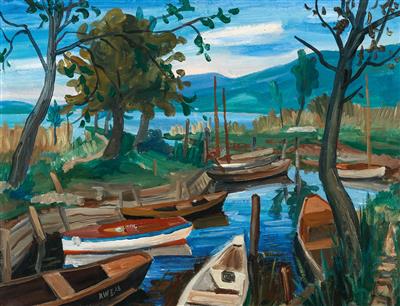Rudolf Wacker

(Bregenz 1893–1939)
“Bodenseelandschaft”, 1928, Oil on cardboard, monogrammed and dated RW X.28, on the reverse inscribed, signed and dated B 65 H 50 / R. WACKER / Bregenz, 8. X.28 / “Bodenseelandschaft”, 50 x 65 cm, framed
Illustrated and Registered:
Max Haller, Rudolf Wacker. 1893–1939. Biografie mit dem Oeuvre-Katalog des malerischen Werkes, Lustenau 1971, cat. no. 115
Provenance:
Hassfurther, 30. 5. 2005, lot 100
Kunsthandel Walter Moskat, Bregenz
Private Collection, Salzburg
“Painted outdoors every day this week, every day in front of a new subject, advancing from the new objectivity to ‘new productivity’!”
(Rudolf Wacker, diary note, 23. 10. 1927, in: Rudolf Sagmeister (ed.), Rudolf Wacker. Bekenntnisse, Lustenau 1983, n.p.)
In around 1927, Rudolf Wacker discovered the beautiful natural landscapes along the small spring rivers that flow into Lake Constance near Bregenz around the Mehrerau monastery. The surroundings at the mouth of the Bilgeribach quickly became one of his favorite subjects, which he captured in situ, in various studies throughout the changing seasons. These relatively large-format pictures painted on cardboard are among his most impulsive works. He led the brush loosely and dynamically, applied the colours unmixed and vigorously and preferred the large outline form to a detailed execution. In contrast to the paintings done later in the studio in the new-objectivity style, the studies convey an immediate, intimate monologue between the artist, nature and his inner feelings.
Max Haller, Rudolf Wacker 1893–1939. Biografie mit dem Oeuvre-Katalog des malerischen Werkes, Lustenau 1971, WV-Nr. 115 (ohne Abb.)
The work “Blind Cripple” by George Grosz was created in the Golden Twenties of the Weimar Republic. It was a time when the new art movement called New Objectivity was reacting to the social and political grievances of the country. Artists began to capture these challenges visually. This is also how Grosz described his observations of everyday life: “When I began to experience the world, I soon discovered that the colourfulness, the glamour, above all, my fellow human beings were not very good.”
(Presler, G.: Glanz und Elend der 20er Jahre. Die Malerei der Neuen Sachlichkeit, Cologne 1992, p. 52.)
Esperta: Dr. Marianne Hussl-Hörmann
 Dr. Marianne Hussl-Hörmann
Dr. Marianne Hussl-Hörmann
+43-1-515 60-765
marianne.hussl-hoermann@dorotheum.at
22.06.2021 - 16:00
- Prezzo realizzato: **
-
EUR 87.800,-
- Stima:
-
EUR 60.000,- a EUR 100.000,-
Rudolf Wacker
(Bregenz 1893–1939)
“Bodenseelandschaft”, 1928, Oil on cardboard, monogrammed and dated RW X.28, on the reverse inscribed, signed and dated B 65 H 50 / R. WACKER / Bregenz, 8. X.28 / “Bodenseelandschaft”, 50 x 65 cm, framed
Illustrated and Registered:
Max Haller, Rudolf Wacker. 1893–1939. Biografie mit dem Oeuvre-Katalog des malerischen Werkes, Lustenau 1971, cat. no. 115
Provenance:
Hassfurther, 30. 5. 2005, lot 100
Kunsthandel Walter Moskat, Bregenz
Private Collection, Salzburg
“Painted outdoors every day this week, every day in front of a new subject, advancing from the new objectivity to ‘new productivity’!”
(Rudolf Wacker, diary note, 23. 10. 1927, in: Rudolf Sagmeister (ed.), Rudolf Wacker. Bekenntnisse, Lustenau 1983, n.p.)
In around 1927, Rudolf Wacker discovered the beautiful natural landscapes along the small spring rivers that flow into Lake Constance near Bregenz around the Mehrerau monastery. The surroundings at the mouth of the Bilgeribach quickly became one of his favorite subjects, which he captured in situ, in various studies throughout the changing seasons. These relatively large-format pictures painted on cardboard are among his most impulsive works. He led the brush loosely and dynamically, applied the colours unmixed and vigorously and preferred the large outline form to a detailed execution. In contrast to the paintings done later in the studio in the new-objectivity style, the studies convey an immediate, intimate monologue between the artist, nature and his inner feelings.
Max Haller, Rudolf Wacker 1893–1939. Biografie mit dem Oeuvre-Katalog des malerischen Werkes, Lustenau 1971, WV-Nr. 115 (ohne Abb.)
The work “Blind Cripple” by George Grosz was created in the Golden Twenties of the Weimar Republic. It was a time when the new art movement called New Objectivity was reacting to the social and political grievances of the country. Artists began to capture these challenges visually. This is also how Grosz described his observations of everyday life: “When I began to experience the world, I soon discovered that the colourfulness, the glamour, above all, my fellow human beings were not very good.”
(Presler, G.: Glanz und Elend der 20er Jahre. Die Malerei der Neuen Sachlichkeit, Cologne 1992, p. 52.)
Esperta: Dr. Marianne Hussl-Hörmann
 Dr. Marianne Hussl-Hörmann
Dr. Marianne Hussl-Hörmann
+43-1-515 60-765
marianne.hussl-hoermann@dorotheum.at
|
Hotline dell'acquirente
lun-ven: 10.00 - 17.00
kundendienst@dorotheum.at +43 1 515 60 200 |
| Asta: | Arte moderna |
| Tipo d'asta: | Asta in sala con Live Bidding |
| Data: | 22.06.2021 - 16:00 |
| Luogo dell'asta: | Wien | Palais Dorotheum |
| Esposizione: | 17.06. - 22.06.2021 |
** Prezzo d’acquisto comprensivo dei diritti d’asta acquirente e IVA
Non è più possibile effettuare un ordine di acquisto su Internet. L'asta è in preparazione o è già stata eseguita.
